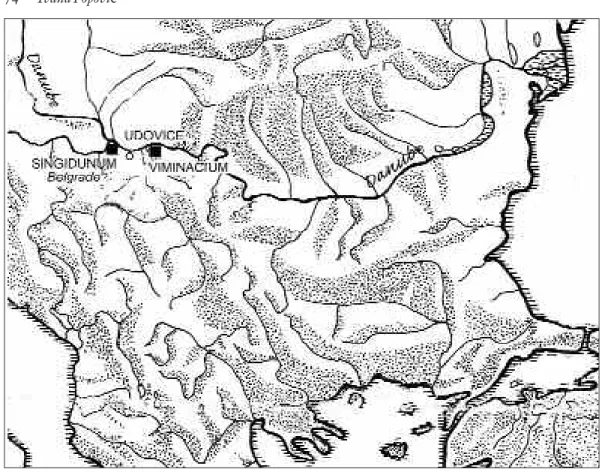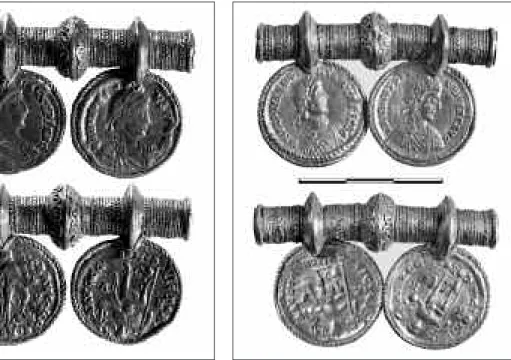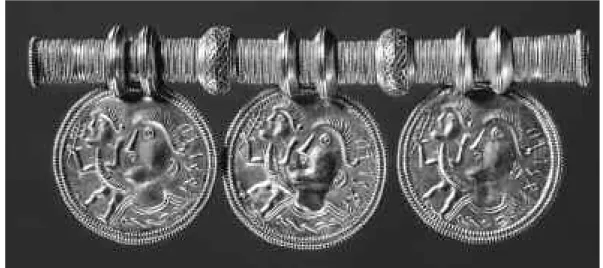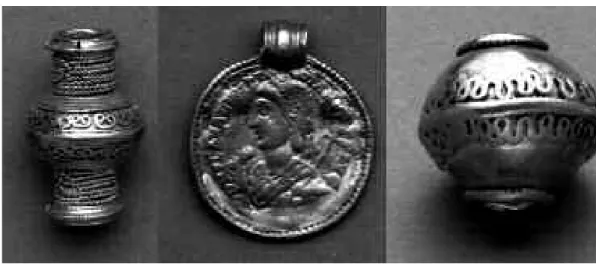Two gold pendants, each consisting of a fili-greed tube acting as a suspension loop for two attached solidus coins, were found in 1906 and 1925 at the village of Udovice. This is in Serbia, near Grocka, some 20 km down the Danube from Belgrade. The site was once on the road between two legionary camps, Singidunum and Vimina-cium(fig. 1). In the absence of any archaeological excavations in Udovice, the find context is un-known. Both pendants were acquired by the Na-tional Museum in Belgrade. Unfortunately, one was stolen from the museum’s permanent exhibi-tion in 1978. With the aid of the inventory no-tes, photographs and a plaster cast, however, many of its characteristics can still be determined. The two pendants are identical (figs. 2–3) and display the same profile, clearly belonging to the same set of jewellery. The tubes have a circular cross-section, length 48 mm, and have moulded openings framed with thick twisted wire. Their entire surface is decorated with thicker and
thin-ner twisted wire, alternating motifs of unbeaded herringbone and straight beaded wire. At the middle of each tube is a biconical cuff consisting of two rings joined by two ribs and decorated with a row of reduced beaded-wire peltae. This cuff divides each tube into two symmetrical parts. At the middle of each half is a slimmer cuff consisting of two parts joined by twisted wire. Each of these side cuffs holds a solidus in a notch on its lower edge. Each solidus is framed with thin twisted wire and each notch with beaded wire.
The 1906 Pendant
A tubular pendant with a solidus of Valentinian III and another one possibly struck during the joint rule of Honorius and Constantius III (fig. 2). Found in 1906, stolen from the National Museum Belgrade in 1978. Length 48 mm, dia-meter of solidi 22 and 23 mm, weight 24.40 g. The solidi are orientated so that the Emperors’
Solidi with Filigreed Tubular Suspension
Loops from Udovice in Serbia
By Ivana Popovi
ć
Popović, I., 2008. Solidi with Tubular Suspension Loops from Udovice in Serbia.
Fornvännen103. Stockholm.
Two gold pendants, each consisting of a filigreed tube acting as a suspension loop for two attached solidus coins, were found in 1906 and 1925 at the village of Udovice. This is in Serbia, near Grocka, some 20 km down the Danube from Bel-grade. One pendant has solidi of Valentinian III and Severus III, the other yet another solidus of Valentinian III and one possibly struck during the joint rule of Honorius and Constantius III. The pendants belong to a necklace made in the 460s in the Gothic cultural circle. Their closest parallels are a pendant with solidi of Theodosius II from Lübchow in Pomerania and pendants with gold bracteates from Kongsvad å and Stenholts vang on Zealand.
Ivana Popović Archaeological Institute, Knez Mihailova 35, 11000 Belgrade, Serbia ivpop@eunet.yu
portraits are approximately right-side-up when the tube is held horizontally.
1. AV. DNPLAVALENTI – NIANVSPFAVC. Emperor’s bust facing right, wearing paluda-mentumcloak fastened with circular brooch with pendants; on his head a crown with pen-diliapendants.
1. RV. VICTORI – AAVCCC. Emperor en-throned. In his right hand a long cross, in his left hand a globe with Victoria above it. Right foot is on a snake with human head. In field: left R, right V. In ex.: COMOB. Solidus ra-ther worn, struck in Ravenna for Valentinian III (425–455; see Cohen 1930, 212, no. 19). 2. AV. DNHONORI – VSPFAVC. Emperor’s bust facing right, wearing paludamentum cloak fastened with circular brooch with pendants; on his head a crown with pendilia pendants. 2. RV. VICTORI – AAVCCC. Emperor
stan-ding, facing right. In his right hand a long labarummilitary standard, in the left a globe with Victoria above it. Left foot is on a cap-tive. In field: left R, right V. In ex.: COMOB. Worn solidus, struck in Ravenna, possibly during the joint rule of Honorius and Con-stantius III (AD 421; see Cohen 1930, 227, no. 44–45).
Bibl.: Vasić (1906) 1907, p. 208; Garaša-nin 1951, p. 182, plate XXIV b; GarašaGaraša-nin & Kovačević 1961, plate LXII; Vasić 1992, p. 294; Popović 1993, p. 53–54, plates IV, 11, 11 a; Popović 2001, p. 53–58, 202–204, cat. 67a. The 1925 Pendant
A tubular pendant with solidi of Valentinian III and Severus III (fig. 3). Found in 1925, National Museum Belgrade, inv. 556/IV. Length 48 mm, diameter of solidi 22 mm, weight 25.18 g. The
solidi are orientated so that the Emperors’ por-traits are approximately right-side-up when the tube is held horizontally.
1. AV. DNPLAVALENTI – NIANVSPFAVC. Emperor’s bust facing right, wearing paluda-mentumcloak fastened with circular brooch with pendants; on his head a crown with pendiliapendants.
1. RV. VICTORI – AAVCCC. Emperor en-throned. In his right hand a long cross, in his left hand a globe with Victoria above it. Right foot is on a snake with human head. In field: left R, right V or M. In ex.: COMOB. It is not clear whether the right-hand field reads V (Ravenna) or M (Roma). Worn so-lidus struck in Ravenna or Rome for Valen-tinian III (425–455; see Cohen 1930, 212, no. 19).
2. AV. DNLIBIVSSEV – ERVSPFAVC. Em-peror’s bust facing right, wearing paludamen-tumcloak fastened with circular brooch with
pendants; on his head a crown with pendilia pendants.
2. RV. VICTORI – AAVCCC. Emperor en-throned. In his right hand a long cross, in his left hand a globe with Victoria above it. Right foot is on a snake with human head. In field: left R, right V. In ex.: COMOB. Uncir-culated solidus struck in Ravenna for Seve-rus III (461–465; see Cohen 1930, 227, no. 8).
Bibl.: Saria 1925, p. 319; Garašanin 1951, p. 182; Vasić 1992, p. 294; Brenot, Metzger 1992, p. 337, no. 67; Popović 1993, p. 53, plates IV, 10, 10 a; Popović 2001, p. 53–58, 202–204, fig. 9, cat. 67.
Historical Context
The numismatic analysis offers a number of use-ful insights. Of the four solidi, the youngest is that of Severus III (461–465) which appears to be uncirculated. This indicates that the pen-dants were made in the 460s. Geographically
Fig. 2. Gold pendant with solidi found in 1906 at Udovice. Length 48 mm. A: averse. B: reverse. Pho-tograph National Museum, Belgrade.
Fig. 3. Gold pendant with solidi found in 1925 at Udovice. Length 48 mm. A: averse. B: reverse. Pho-tograph N. Borić, National Museum, Belgrade.
speaking, the solidi come from Ravenna and possibly Rome, that is, western mints whose issues are rare in the Serbian part of the Danube region. This may have to do with historically documented events.
After the invasion of the Huns, Roman bor-der defences along the Danube were destroyed in 441. This gap in the border allowed an incur-sion of Germanic tribes, the Ostrogoths above all, onto the right-hand bank of Danube and into the Balkan hinterland. In 468, Anthemius (who would go on to become first magister mili-tum and then Emperor of the West), together with magister militum illyricum Marcellinus, led them on a military campaign against Italy, which was at that time mostly controlled by Vandals. When magister militum Aspar and Vandal lea-der Genseric made a separate truce, the Gothic troops appear to have left Italy (Stein 1968, pp. 389–391). At this time, solidi struck in Italy may have been taken back into the Balkans as war booty.
Previous Discussion
Although the Udovice pendants are extraordinary examples of Migration Period goldsmith work, they have not received much attention in Ser-bian scholarship. Beside notes on their acquisi-tions by the National Museum in Belgrade (Vasić (1906) 1907, p. 206; Saria 1925, p. 319) they have only been mentioned briefly by Garašanin (1951, p. 182, plate XXIV b) who interpreted them as military decorations, and by Garašanin & Ko-vačević (1961, plate LXII) who called them con-torniatae. Vasić (1992, p. 294) published the first detailed numismatic evaluation of the four coins. This allowed Brenot & Metzger (1992, p. 337, no. 67) to include the extant pendant from Udovice in their study of coin jewellery from the western provinces of the Empire.
About the same time, I wrote notes on the pendants and interpreted them as parts of a necklace (Popović 1993, p. 53–54, 58–59, plate IV, 10, 11). In a later work (2001, pp. 202–204, fig. 1.1–3, cat. 67, 67a) I suggested that the solidi pendants were a barbarian interpretation of Ro-man coin necklaces, which were common from about 250 onward.
Parallels
The Udovice pendants are similar to medallions mounted on analogous tubular loops in the Szilá-gysomlyó hoard from Transylvania. In 2001, I left the possibility open that they may once have hung on a wire connecting the ends of an open neck-ring. The Szilágysomlyó hoard, whose de-position is dated to 400–450, contained 14 gold medallions, the latest struck for Gratian (367– 383). They were fixed on variously decorated tu-bular loops, and of the tubes that carried two medallions of Valens, each had three circular cuffs for fastening them (Seipel 1999, pp. 117– 118, Abb. 6, 163, Kat. nr. F12). The manner of construction, the culture-historical context and the time of deposition suggest close parallels between the finds from Szilágysomlyó and Udo-vice.
As J.P. Lamm has kindly pointed out to me, certain gold jewellery from the Baltic region sheds additional light on the Udovice pendants. At Lübchow in the Kolberg-Körlin district of Pomerania (currently in Poland) a gold pendant with a tubular loop and three solidi has been found. The coins were struck for Theodosius II (408–450) in Constantinople and Thessaloniki (La Baume 1963, p. 21, Abb. 1,2). The find pro-bably also contained other gold jewellery, in-cluding bracteates, and coins. The latest of these associated coins is a solidus of Leo I (457–474). On this basis, and in spite of some dilemmas, La Baume (1963, p. 22–24) dated the Lübchow find to 450–500. The Lübchow pendant’s tubular loop is grooved, and between the five cuffs it is wrapped with thin filigree wire. The coins are fixed to the first, third and fifth cuff. The way in which the solidi are mounted here is slightly dif-ferent from the one at Udovice, where the coins are mounted in filigree wire rings suspended from the cuffs on the tube.
The Udovice fastening method appears on similar pendants from two sites on Zealand in Denmark, Kongsvad å and Stenholts vang, where the tubes carry Scandinavian gold bracteates in-stead of solidi. The Kongsvad å pendant (fig. 4) has three bracteates. The three pendants from Stenholts vang have two bracteates each (fig. 5), fastened to the tubes with filigree wire rings, while there is a thick cuff decorated with filigree
peltae at the middle of the tube (Goldbrakteaten 1985, pp. 180–181, no. 101; 308–309, no. 179; Taf. 128, 233; Jørgensen & Vang Petersen 1998, pp. 240, 243). The design of these tubes and the way the bracteates are fastened to them is entire-ly analogous to the Udovice pendants. Indeed, the ring-shaped filigree-wire edge-trim of Scan-dinavian bracteates in general is often identical to what we see at Udovice.
In addition to the pieces mentioned above, similar tubular loops are known from many sites in Sweden and Denmark (Lamm 1991/3, p. 156, Abb. 3; 1998, p. 338, Abb. 56). In 2001 a metal de-tectorist at Fuglsang/Sorte Muld on Bornholm
found what appear to be parts of a complete gold-pendant necklace, folded into part of a Roman silver dinner plate (Axboe 2002). The necklace consists of six solidi of Valentinian III made into pendants, five bracteates and two fili-gree cross pendants, all separated on the string by ten filigree tubes of the same kind as at Udovice, only smaller, and two spheroid beads (fig. 6; bornholmsmuseum.dk/arkeologi/solv-tar.htm). Some single Scandinavian gold brac-teates, such as those from Gerete and Eskatorp in Sweden (Arrhenius 1988, p. 466, kat. 15, 16, Taf. 78/XI, 15; 79/XI, 16) also have tubular loops. The magnificent gold filigree collars from
Ålle-Fig. 4. Gold pendant with bracteates found at Kongsvad å on Zealand. Photograph National Museum, Copen-hagen.
Fig. 5. Gold pendant with bracteates found at Stenholts vang on Zealand. Photo-graph National Museum, Copenhagen.
berg, Färjestaden and Möne, and also gold bra-celets and parts of necklaces found in Denmark, are made of row upon row of similar filigreed tubes.
Opinions have differed about the exact time when this body of gold-tube jewellery was pro-duced, with dates suggested from c. 300 until shortly after 600 (Lamm 1998, p. 339–400). Evi-dently, however, it all belongs to the same cul-tural circle. The finds discussed offer evidence to place this group of material in a chronological and culture-historical context.
Contacts North and South-East
Prehistoric Scandinavia was exposed to cultural influences from the Black Sea region at least from the Bronze Age onward. Connections be-tween the two regions became particularly in-tense during the reign of Theodoric the Great (451–526). Among the objects that bear witness to this are numerous Scandinavian finds of Go-thic-Byzantine style metalwork and faceted glass drinking cups (Arrhenius 1988, pp. 441–447, Abb. 3–4). Material culture in Scandinavia c. 450– 550 developed in close contact with the Gothic cultural circle, which, in its turn, was to a great extent shaped through its adoption and trans-formation of the Roman heritage. The tubular
pendant loops with solidi are a fine example of these complex connections and relations. They are a barbarian interpretation of Roman coin necklaces, which were, particularly from about 250 onward, common mainly in the eastern parts of the Empire.
Most finds of these coin necklaces have been made in Egypt (Popović 2001, p. 203). In these jewellery sets (e.g. Yerolouanu 1999, Cat. 2,3,7), the tubes separate the coin pendants, which hang from multiple gold chains. In the Szilágysomlyó hoard, which belongs to a Germanic cultural mi-lieu of the early 5th century, we find medallions fixed to tubular filigree loops. This idea is fur-ther developed on the somewhat later solidi jew-ellery from Udovice and Lübchow.
Judging from the coins used – solidi of Theo-dosius II, Honorius & Constantius III, Valenti-nian III and Severus III – such pendants were made during a brief period in the second half of the 5th century. The solidi of Theodosius II on the Lübchow pendant are from eastern mints, Constantinople and Thessaloniki, which hints at the innovation centre behind the idea. The Udovice solidi are western issues from Ravenna and perhaps Rome. This is in all probability a consequence of military expeditions during that tumultuous period. At Lübchow, beside the
soli-Fig. 6. Selected pieces from a gold hoard found folded into a Roman silver plate at Sorte Muld on Bornholm. A: tubular spacer bead. B: solidus coin with simple loop. C: spheroid spacer bead. All shown at slightly differ-ent scales. Photographs John Lee, National Museum, Copenhagen.
di pendant, were found gold bracteates; and six bracteates are in the same hoard from Sorte Muld as the coin necklace with solidi of Valen-tinian III. Thus, necklaces with solidi and with bracteates are coeval. The Sorte Muld necklace also shows that at the same time as tubular loops were made, solidi were also fitted with small loops and hung on necklaces separated by small filigreed tubes.
Another conclusion that may be drawn from these finds is that bracteates and solidi were fitted with tubular loops about the same time, though the bracteate version may have survived some-what longer. The bracteates with tubular loops in all probability represent a Scandinavian adap-tation of a Continental concept, this being the final descendant of the Roman coin necklace cus-tom from 250–300. The Swedish gold filigree col-lars and associated material demonstrate anoth-er direction in which the tubular jewellanoth-ery de-veloped. This work possibly found its inspira-tion in impressive Gothic necklaces like that from Pietroassa (Odobescu 1889–1900; Gold-helm 1994, p. 232, Kat. 98:4).
As for the solidi with tubular loops, it seems likely that they belong to the Ostrogothic cul-tural circle, and that they were the property of the elite, though no coeval Gothic filigree work is known. Is it possible that during the second half of the 5th century this jewellery was made according to the taste of Goths in Constantinop-le itself? Or in some center on the Black Sea coast, or in local workshops that kept contact with such centres, nurturing the traditions of Roman-Byzantine goldsmith work?
References
Arrhenius, B., 1998. Skandinavien und Osteuropa in der Völkerwanderungszeit. Menghin, W. et al. (eds).
Germanen, Hunnen und Awaren. Schätze der Völker-wanderungszeit. Nuremberg.
Axboe, M., 2002. Sølvkræmmerhuset og Balders død. Pind, J. et al. (eds). Drik – og du vil leve skønt.
Fest-skrift til Ulla Lund Hansen på 60-årsdagen 18. augusti 2002. National Museum. Copenhagen.
Brenot, C. & Metzger, C., 1992. Trouvailles de bijoux monétaires dans l'occident romain. L'or monnayé
III. Trouvailles de monnaies d'or dans l'occident ro-main. Cahiers Ernest-Babelon 4. Paris.
Cohen, H., 1930. Description historique des monnaies
frappées sous l’empire romaineVIII. Leipzig.
Goldbrakteaten1985. M. Axboe et al. Die Goldbrakteaten
der Völkerwanderungszeit1:2 Ikonographischer
Kata-log. Munich.
Garašanin, M. i D., 1951. Arheološka nalazišta u Srbiji. Belgrade.
Garašanin, M. & Kovačević, J., 1961. Arheološki nalazi u Jugoslaviji.Belgrade.
Goldhelm 1994. Goldhelm, Schwert und Silberschätze.
Reichtümer aus 6000 Jahren rumänischer Vergangen-heit. Frankfurt am Main.
Jørgensen, L. & Vang Petersen, P., 1998. Guld, magt og
tro. Danske skattefund fra oldtid og middelalder. Na-tionalmuseet. Copenhagen.
La Baume, P. 1963. Ein Goldschmuck aus Lübchow in Pommern. Studien zur Geschichte des Preussenlandes. Marburg.
Lamm, J.P., 1991. Zur Taxonomie der schwedischen Goldhalskragen der Völkerwanderungszeit.
Forn-vännen86.
– 1998. Goldhalskragen. Reallexikon der
Germanis-chen Altertumskunde. Bd. 12. Berlin.
Odobescu, Al., 1889–1900. Le trésor de Pétroassa. Paris. Popović, I., 1993. Rimski monetarni nakit u Srbiji
(ré-sumé: Les bijoux monétaires de Serbie).
Numi-zmatičar 16. Belgrade.
– 2001. Late Roman and Early Byzantine Gold Jewellery
in National Museum in Belgrade. Belgrade.
Saria, B., 1925. Narodni muzej u 1925. Izveštaj o stan-ju i radu u praistorijskoj, klasičnoj i numizma-ti_koj zbirci. Godišnjak Srpske Kraljevske Akademije
XXXIV. Belgrade.
Seipel, W. (ed.)., 1999. Barbarenschmuck und
Römer-gold. Der Schatz von Szilágysomlyó. Eine Ausstellung des Kunsthistorischen Museums Wien und des Magyar Nemzeti Múzeum. Vienna.
Stein, E., 1968. Histoire du Bas-Empire. Amsterdam. Vasić, M., 1906 (1907). Izveštaji o stanju i radu u 1906.
II Narodni muzej, Godišnjak Srpske Kraljevske
Aka-demijeXX. Belgrade.
– 1992. Les découvertes de monnaies d'or dans le diocèse de Dacie du IVe au VIe siècle. L'or monnayé
III. Trouvailles de monnaies d'or dans l'occident ro-main. Cahiers Ernest-Babelon 4. Paris.
Yeroulanou, A., 1999. Diatrita. Gold pierced-work
Summary
Two gold pendants, each consisting of a fili-greed tube acting as a suspension loop for two attached solidus coins, were found in 1906 and 1925 at the village of Udovice. This is in Serbia, near Grocka, some 20 km down the Danube from Belgrade.
The tubes have a circular cross-section, length 48 mm, and have moulded openings framed with thick twisted wire. Their entire surface is deco-rated with thicker and thinner twisted wire, al-ternating motifs of unbeaded herringbone and straight beaded wire. At the middle of each tube is a biconical cuff consisting of two rings joined by two ribs and decorated with a row of reduced beaded-wire peltae. This cuff divides each tube into two symmetrical parts. At the middle of each half is a thinner cuff consisting of two parts joined by twisted wire. Each of these side cuffs holds a solidus in a notch on its lower edge. Each solidus is framed with thin twisted wire and each notch with beaded wire.
One pendant has solidi of Valentinian III and Severus III, the other yet another solidus of Valentinian III and one possibly struck during the joint rule of Honorius and Constantius III. The pendants belong to a necklace made in the 460s in the Gothic cultural circle. Their closest parallels are a pendant with solidi of Theodosius II from Lübchow in Pomerania and pendants with bracteates from Kongsvad å and Stenholts vang on Zealand.
Judging from the coins used – solidi of Theo-dosius II, Honorius & Constantius III, Valen-tinian III and Severus III – such pendants were made during a brief period in the second half of the 5th century. Solidi of Theodosius II on a pendant from Lübchow in Pomerania are from eastern mints, Constantinople and Thessaloniki, which hints at the innovation centre behind the
idea. The Udovice solidi are western issues from Ravenna and perhaps Rome. This is in all proba-bility a consequence of military expeditions dur-ing that tumultuous period. At Lübchow, beside the solidi pendant, were found gold bracteates; and six bracteates are in the same hoard from Sorte Muld on Bornholm as a coin necklace with solidi of Valentinian III. Thus, necklaces with solidi and with bracteates are coeval. The Sorte Muld hoard also shows that at the same time as tubular loops were made, solidi were also fitted with small loops and hung on neck-laces separated by small filigreed tubes.
Another conclusion that may be drawn from these finds is that bracteates and solidi were fit-ted with tubular loops about the same time, though the bracteate version may have survived somewhat longer. The bracteates with tubular loops in all probability represent a Scandinavian adaptation of a Continental concept, this being the final descendant of the Roman coin necklace custom from 250–300. The Swedish gold filigree collars demonstrate another direction in which the tubular jewellery developed. This work pos-sibly found its inspiration in impressive Gothic necklaces like that from Pietroassa (Odobescu 1889–1900; Goldhelm 1994, p. 232, Kat. 98:4).
As for the solidi with tubular loops, it seems likely that they belong to the Ostrogothic cul-tural circle, and that they were the property of the elite, though no coeval Gothic filigree work is known. Is it possible that during the second half of the 5th century this jewellery was made according to the taste of Goths in Constantinop-le itself? Or in some centre on the Black Sea coast, or in local workshops that kept contact with such centres, nurturing the traditions of Roman-Byzantine goldsmith work?



